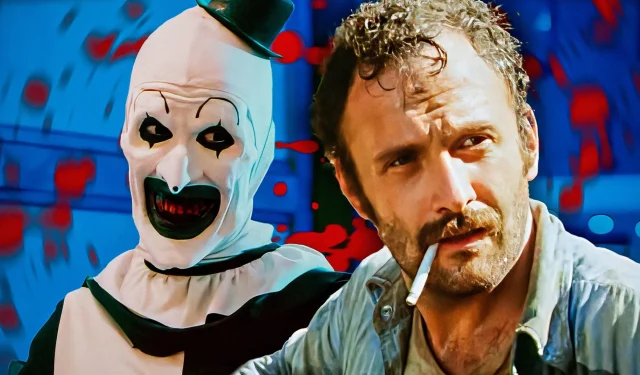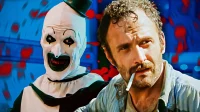Note: The following list contains discussions surrounding graphic violence and sexual assault.
Horror is a genre that thrives on evoking intense emotions such as tension, disgust, and terror. Renowned for its capacity to push boundaries, horror films often explore themes that can make the viewing experience profoundly unsettling. While some films strike the perfect balance between scary and entertaining, there are instances where directors seem to escalate violence or darkness to a point that detracts from the enjoyment of the narrative. This raises an important question: what purpose does excessively morbid content serve in horror cinema?
1. Terrifier 3 (2024)
Directed By Damien Leone
The latest installment in Damien Leone’s Terrifier franchise, Terrifier 3 (2024), serves as a glaring example of the problems that can arise within a series famous for its excessive gore. Following the murderous antics of Art the Clown, played by David Howard Thornton, this film escalates the grotesque content to staggering levels. Scenes such as Cole’s chainsaw demise and Aunt Jessica’s fate involving a rat and feeding tube exemplify the film’s relentless reliance on shock value.
While some audiences appreciate extreme horror, many viewers may find Leone’s creative choices borderline sadistic, prompting them to question whether such disturbing imagery is truly necessary.
2. Cannibal Holocaust (1980)
Directed By Ruggero Deodato
As one of the most notorious entries in horror history, Cannibal Holocaust (1980) follows a rescue mission in the Amazon, aiming to locate a filmmaking crew that vanished while documenting cannibal tribes. Pioneering the found-footage style, Ruggero Deodato’s creation is notorious for its unflinching and realistic depictions of violence.
Deodato faced legal repercussions due to the extreme realism of the film, with rumors suggesting that the actions portrayed were real (source: The Guardian). In addition to horrifying sequences of torture and sexual violence, the film still bears a significant stain on its legacy from the genuine animal deaths it features, complicating its critical acclaim.
3. The Human Centipede 2: Full Sequence (2011)
Directed By Tom Six
In The Human Centipede 2: Full Sequence, Tom Six takes the shock element of horror to an entirely different level. This sequel to the original film lacks any meaningful narrative structure, instead offering an overwhelming display of grotesque horror that leaves little to appreciate.
| Film | Rotten Tomatoes Score |
|---|---|
| The Human Centipede: First Sequence (2009) | 49% |
| The Human Centipede 2: Full Sequence (2011) | 29% |
| The Human Centipede 3: Final Sequence (2015) | 20% |
4. Tusk (2014)
Directed By Kevin Smith
Inspired by a deeply unsettling true story, Tusk revolves around a podcaster named Wallace Bryton, who becomes ensnared by a deranged ex-sailor planning to transform him into a human-walrus hybrid. Amidst moments of dark humor, Kevin Smith’s film is primarily defined by its grotesque body horror.
The excruciating suffering that Bryton endures, from the disturbing use of his severed limbs to the horrific immurement inside a walrus-like suit, makes for an exceptionally uncomfortable viewing experience.
5. Hostel (2005)
Directed By Eli Roth
Co-produced by Quentin Tarantino, Hostel presents a terrifying premise that spirals into excessive brutality. Following two tourists who fall victim to a nefarious organization that tortures its clients, the film blends an innovative concept with relentless gore that many viewers find overwhelming.
Scenes of torture, particularly an unsettling moment where a character operates with a disfigured eyeball, highlight a disconnect between horror’s purposeful intrigue and gratuitous violence. While moderately received, Roth’s film raises the question of how much is too much when it comes to onscreen horror.
6. Antichrist (2009)
Directed By Lars von Trier
Lars von Trier’s Antichrist exemplifies psychological horror through an exploration of grief and suffering, featuring Willem Dafoe and Charlotte Gainsbourg as a couple haunted by their son’s tragic death. Their retreat into a remote cabin unwittingly spirals into a shocking depiction of violence and despair.
Despite any potential philosophical undertones, the film’s brutal portrayals, including scenes of self-harm and mutilation, lend themselves to an experience that may be deemed profoundly unsettling, overshadowing any underlying meaning.
7. Speak No Evil (2022)
Directed By Christian Tafdrup
The 2022 original of Speak No Evil has been praised as one of the year’s most unsettling films, effectively outdoing its English-language remake. Both narratives center around a family’s disturbing engagement with a new friend, ultimately revealing an unthinkable twist.
Christian Tafdrup’s film exhibits a horrifying end where the murderous couple subjects their guests to unspeakable acts, turning a once idyllic holiday encounter into a nightmare. The violent conclusion and underlying themes of deception push the limits of horror, leaving an indelible mark on viewers.
8. Would You Rather (2012)
Directed By David Guy Levy
Would You Rather revisits the familiar party game but in a harrowing context. Featuring a group of financially distressed characters coerced into playing under a twisted billionaire’s whims, the film takes a grim turn as absurd hypothetical scenarios morph into horrifying realities.
The explicit violence woven into the challenges of the game—ranging from self-harm to fatal outcomes—erodes any potential enjoyment as the viewer grapples with the moral implications of the content.
9. Maniac (1980)
Directed By William Lustig
Even decades after its release, Maniac remains notorious for depicting extreme violence without a substantial narrative justification. This psychological slasher follows Frank Zito, a deranged murderer stalking women in New York City.
Despite the talented special effects provided by Tom Savini, the film’s raw brutality and bleak tone often leave audiences desensitized rather than engaged, offering a grueling experience devoid of emotional or thematic depth.
10. The House That Jack Built (2018)
Directed By Lars von Trier
With The House That Jack Built, Lars von Trier explores profound themes of morality and punishment through the lens of a serial killer’s perspective. Following a disturbing 12-year journey, played by Matt Dillon, the film remains harrowing, even in its moments of relative restraint.
Despite offering a poetic conclusion, von Trier’s relentless portrayal of depravity—including a shocking scene of child murder—raises significant concerns about the limits of cinematic representation in horror. In navigating the depths of human darkness, it’s a film that will challenge even the most seasoned of horror enthusiasts.
Source: Screen Rant, The Guardian, and Syfy.


